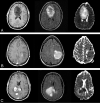Update on brain tumor imaging: from anatomy to physiology
- PMID: 16551981
- PMCID: PMC7976984
Update on brain tumor imaging: from anatomy to physiology
Figures









References
-
- Nolte J. Gross anatomy and general organization of the central nervous system. In: The human brain: an introduction to its functional anatomy. 4th ed. St Louis: Mosby;1999. :51–75
-
- Daumas-Duport C, Beuvon F, Varlet P, et al. [Gliomas: WHO and Sainte-Anne Hospital classifications]. Ann Pathol 2000;20:413–28 - PubMed
-
- Bulakbasi N, Guvenc I, Onguru O, et al. The added value of the apparent diffusion coefficient calculation to magnetic resonance imaging in the differentiation and grading of malignant brain tumors. J Comput Assist Tomogr 2004;28:735–46 - PubMed
-
- Kitis O, Altay H, Calli C, et al. Minimum apparent diffusion coefficients in the evaluation of brain tumors. Eur J Radiol 2005;55:393–400 - PubMed
Publication types
MeSH terms
Grants and funding
LinkOut - more resources
Full Text Sources
Medical
